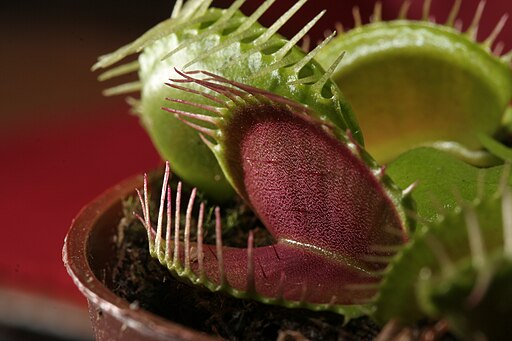Campaign Chunk Volume 13.02 Venus Flytrap
The Venus flytrap, sometimes called Venus’s flytrap or Venus’ flytrap, is the common name of a plant known as Dionaea muscipula. The Venus Flytrap (VFT) is one of the most unusual plants in that it is a carnivorous plant. In other words, it derives some or most of its nutrients from trapping and consuming small animals, typically insects or spiders. It also gets its nutrients from methods that other plants do, such as sugar by photosynthesis. Carnivorous plants live all over the world but the Venus Flytrap is native to select boggy areas in North and South Carolina.
The VT has a series of leaves, called traps, that resemble mouths. Tese are open wide and contain a series of the trigger “hairs”. If one of these is brushed/moved and another with a short period of time, the trap closes quickly, trapping whatever triggered the trap off in the first place within in less than a second. If what sets off the trap is not considered food, such as a small stone or nut, the trap opens up again in around 12 hours.
Once a viable meal has been caught, the VFT shut tightly and form an air-tight seal in order to keep the digestive fluids inside and bacteria out. The trap constricts tightly around the insect and secretes digestive juices, in much the same way as an animals digestive system. The process of digestion takes around 5 to 12 days, then the digestive juices are reabsorbed and anything that could not be consumed, such as an endoskeleton, are washed or blown away.
The VFT, under ideal growth conditions it will reach a maximum size of about 13 cm, or 5 inches, in diameter for the entire plant, with a single leaf trap being around 3cm or 1 inch, in length. They have proven to be popular houseplants for any people, as the obvious advantage to dealing with flys and insects is readily apparent.
Hooks & Rumours
- Evidence has been discovered that a VFT large enough to “eat” a human-sized creature once existed. What is puzzling is that there has been no evidence of an intermediate size VFT, between the standard size and the so-called “Uber” VFT, leading many to believe that it is a hoax.
- A competition has been set-up by growers of the VFT to see how many insects their plants can eat in a single month. All was going well until one of the competitors was caught trying to use fake insects to, for want of a better term, poison the opposition. Although he was disqualified and went into hiding, it was found out that these “fake flies” could be easily modified to make excellent food sources for the VFT. A modest reward is being offered to convince the cheater to reveal how they did it.
- A curious property about the VFTs enzymes has been discovered. When mixed with other common chemicals, it makes an excellent treatment for scarred and damaged skin. It is believed that enzymes “eat away” the scar tissue, but tests are still ongoing to determine the validity of this claim. The university running the trial is looking for scarred volunteers to help test out this new and experimental treatment.
Volume 12 (Creatures) of the compiled and updated Campaign Chunks is available at:
DrivethruRPG.com – http://www.drivethrurpg.com/product/198692/Campaign-Chunk–Volume-12–Creatures
Open Gaming Store – https://www.opengamingstore.com/collections/ennead-games/products/campaign-chunk-volume-12-creatures
If you enjoyed this post, please comment below, or, hit the like/fav button for the social media platform of your choice.





